 "user314" (user314)
"user314" (user314)
09/10/2020 at 11:00 • Filed to: flightline, Planelopnik, planelopnik history, strategic air command, b-36
 6
6
 0
0
 "user314" (user314)
"user314" (user314)
09/10/2020 at 11:00 • Filed to: flightline, Planelopnik, planelopnik history, strategic air command, b-36 |  6 6
|  0 0 |
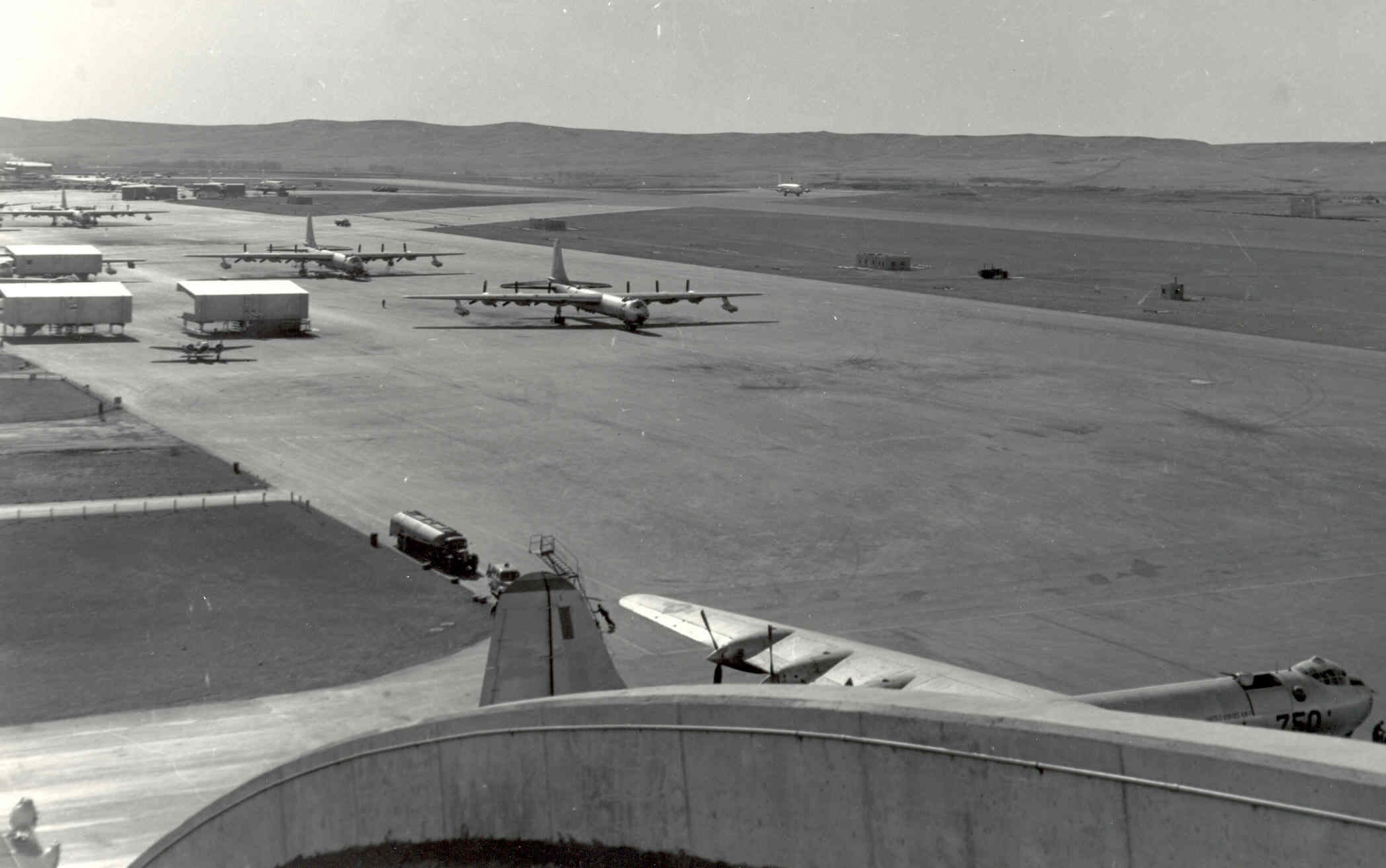
“Six turning, four burning”
!!!error: Indecipherable SUB-paragraph formatting!!! , Rapid City, SD, the early 1950s
The Consolidated Vultee (later Convair) !!!error: Indecipherable SUB-paragraph formatting!!! was the largest mass-produced piston-engined aircraft, had the longest wingspan of any mass-produced airplane, and (on the prototype at least) had the largest wheels ever fitted to an aircraft.
All the way back in 1941, the USAAC began to look for alternatives should the UK fall to the German Blitz. On 11 April 1941, the Air Corps set initial requirements for a new bomber, capable of flying from bases in Newfoundland to Berlin and back, with a top speed of 450mph and a ceiling of 45,000 feet. No manufacturer was able to meet these specs, so in August the Army revised the requirements to a max range of 12,000 miles, a combat range of 4,000 miles with a 10,000lb bombload, with a cruising speed between 240 and 300mph and a ceiling of 40,000, still well beyond the reach of German AAA.
Consolidated’s design, initially designated the Model B-35, was the victim of continual delays, with the company being told to sacrifice work on the larger bomber to concentrate on building B-24s. A mockup was inspected on 30 July 1942, however a change from a twin-tail to a single large stabilizer and rudder, saving weight but pushing back delivery by 120 days. Further delays were encountered when the project was moved from San Diego to Fort Worth.
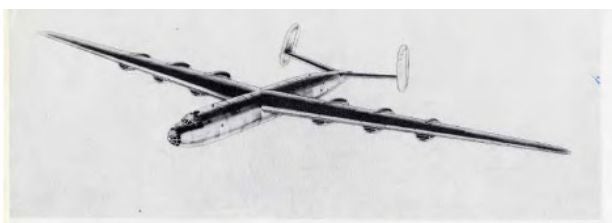
Artists’ impression of the initial B-36 design...
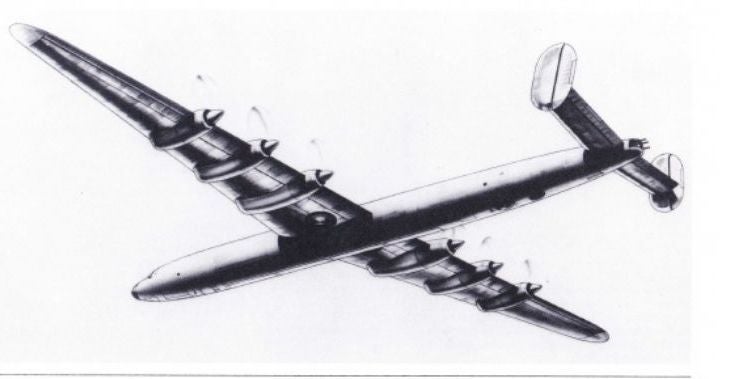
...the influence of Consolidated’s B-24 is visible, but the eventual B-36's lines are clear
Despite USAAF pressure to have the plane in service in the Pacific Theater, the first YB-36 didn’t fly until 8 August 1946. The prototype still featured a single-wheel main landing gear, with each 9 foot tall tire weighing 1,320lb. This arraignment put so much pressure on the runway and taxiways that the B-36 would be limited to only three airbases, Convair’s plant in Ft Worth, Eglin AFB in Florida and Travis AFB in California.

The XB-36 coming in for a landing. The size of the main wheels is apparent
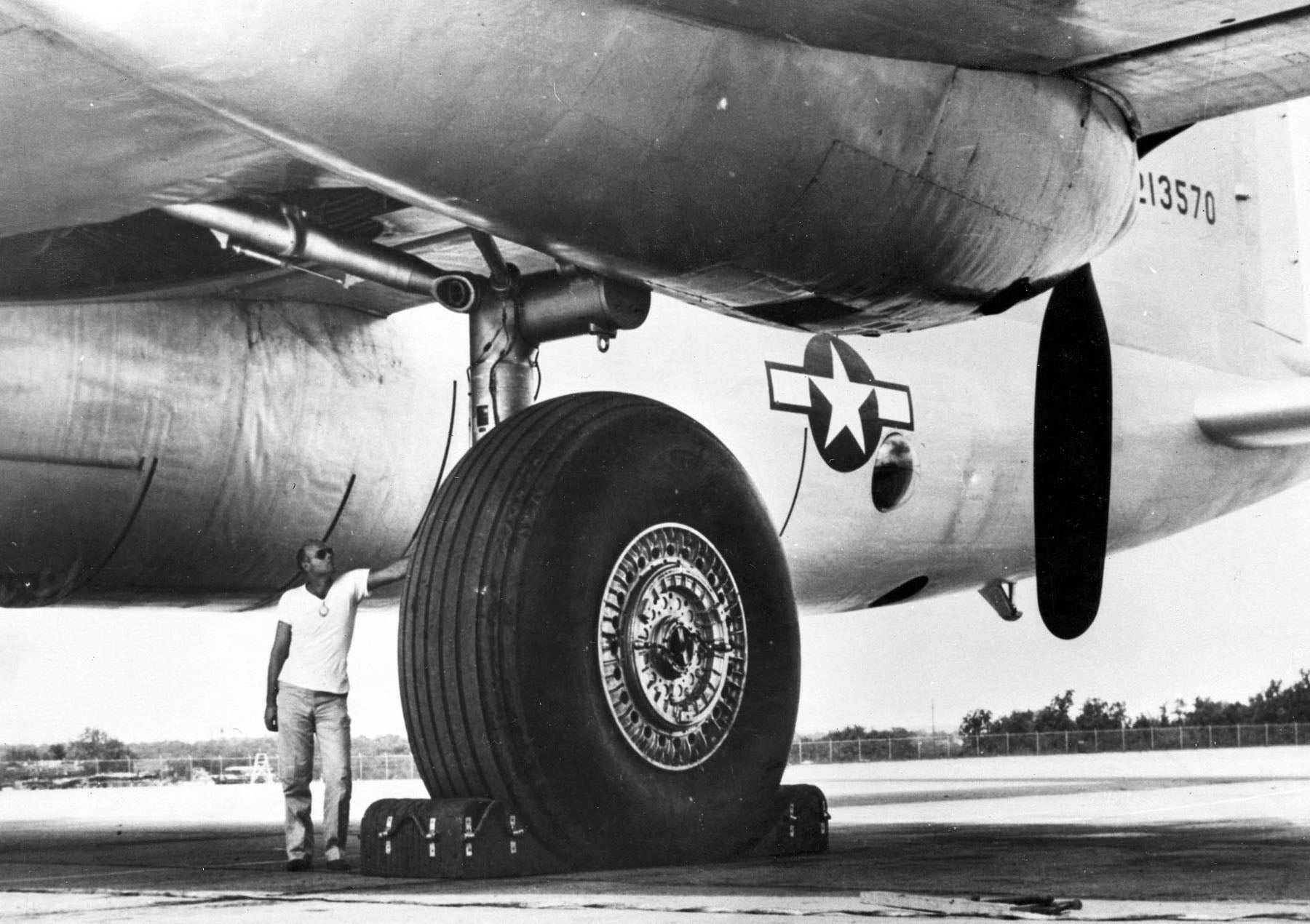
Closeup of the main landing gear. Standard human for scale.
At the prodding of !!!error: Indecipherable SUB-paragraph formatting!!! , Convair redesigned the main landing gear with a four-wheel bogie, which better distributed the plane’s massive weight, allowing the B-36 to land at any USAF base. This change shaved 1,500 pounds off the airplane, though it also further delayed the Peacemaker, now one year behind schedule.

An RB-36H on display. Note the smaller four-wheeled main landing gear.
The Peacemaker entered service in 1948, with 21 B-36A serving as training and transition aircraft. The -A model featured a new domed canopy and the four-wheel main gear, though it lacked the six retractable defensive turrets and fore and aft barbettes. The next model, the B-36B, featured those turrets, as well as uprated !!!error: Indecipherable SUB-paragraph formatting!!! -41 engines. As these models entered service, the A models were sent back to Convair and converted into RB-36E strategic reconnaissance airplanes.
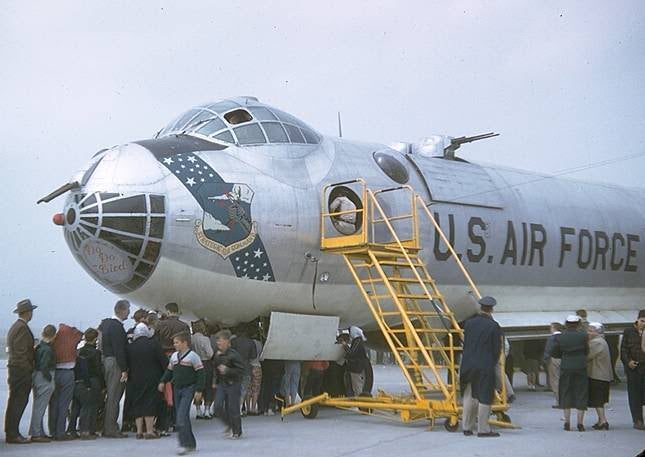
Undated photo showing a B-36 with the forward turrets extended.
The B-36D was the first model to add four J-47 turbojet engines in two pods, which increased power on takeoff and allowed the plane to dash over its target. This configuration led to crews saying they had “Six turning and four burning”, though issues with early jets, and continuing issues with the piston engines (owing to the pusher configuration) more often than not turned into “two turning, two burning, two smoking, two choking, and two more unaccounted for.“
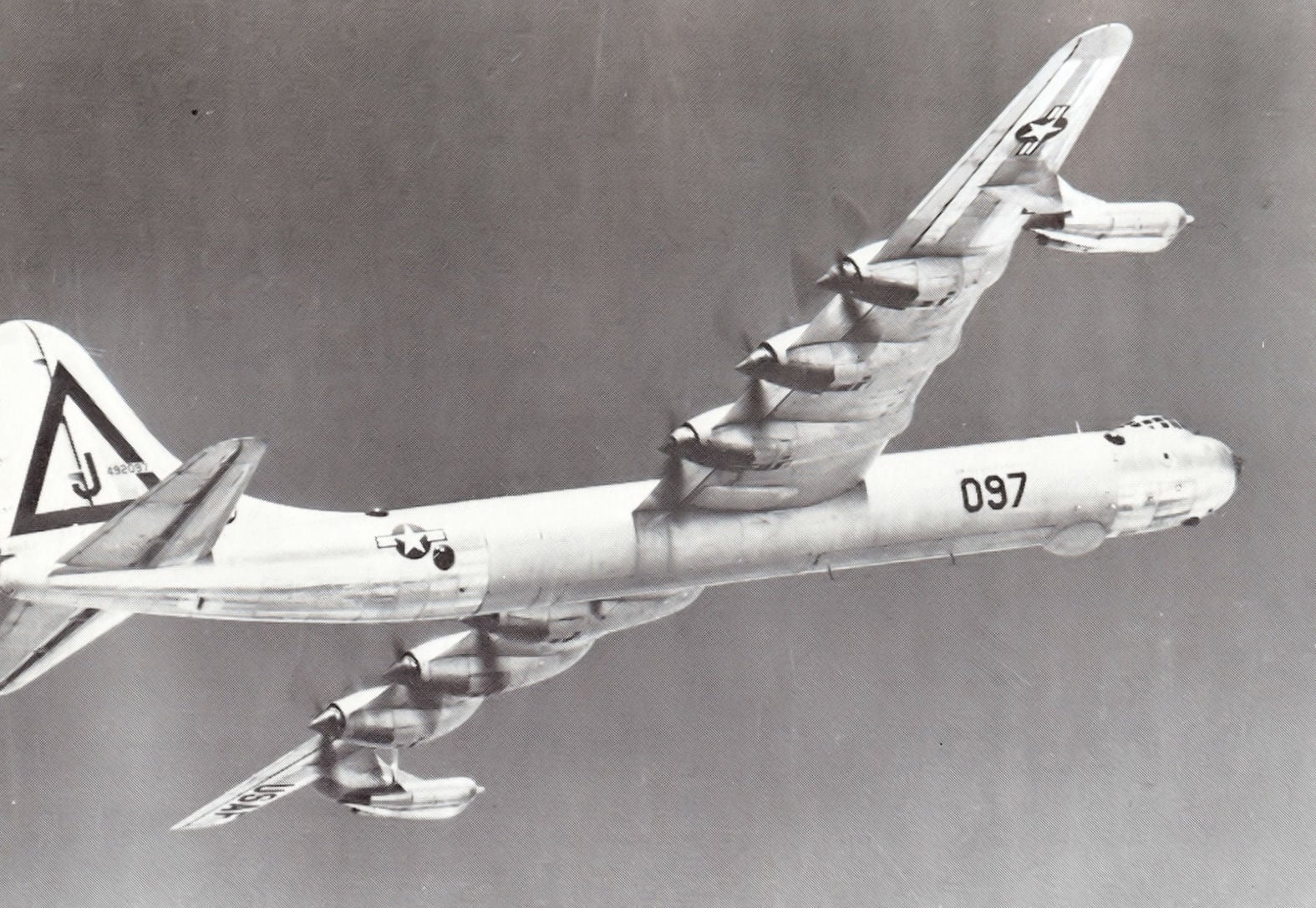
7th Bombardment Wing Consolidated B-36D-1-CF Peacemaker 44-92097, showing Triangle-J tail code. 92097 crashed near Biggs AFB 8/28/54 due to loss of engine power on practice landing approach. One crew killed
Seventeen aircraft were built as RB-36D, with the bomb-bays holding camera installations. The YB-36A and B-36As were converted to the same configuration, though they were designated RB-36Es. The B-36F featured uprated R-4360-53 piston engines, but were otherwise unchanged; 24 additional aircraft were built as RB-36Fs, which were strategic reconnaissance variants. The B-36H had the same engines as the -F, but had an improved flightdeck and changes to internal equipment; as before, the RB-36H was a recon variant. The final production variant, the B-36J, had increased fuel capacity and strengthened landing gear.
Beginning in 1954, the USAF contracted with Convair to begin a series of programs to lighten the B-36, with “Featherweight I” eliminating the retractable turrets and lessened the crew from 15 to 9, and “Featherweight II” removing the crew bunks in the aft compartment and the hardware for the !!!error: Indecipherable SUB-paragraph formatting!!! parasite fighter. “Featherweight III”, which combined both programs, gave the B-36 a longer range and a flight ceiling of 47,000 feet (58,000 for the RB-36D-III).
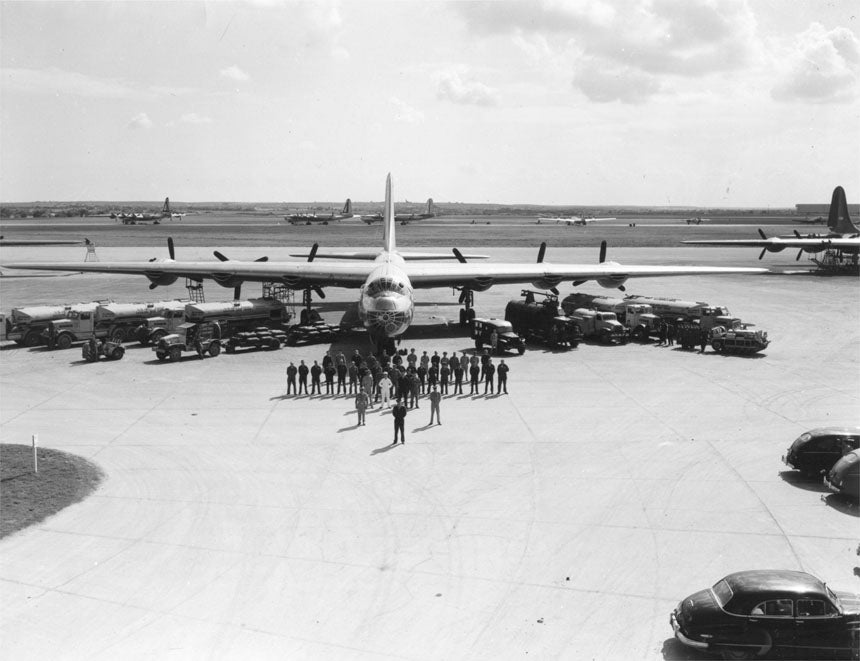 !!!CAPTION ERROR: MAY BE MULTI-LINE OR CONTAIN LINK!!!
!!!CAPTION ERROR: MAY BE MULTI-LINE OR CONTAIN LINK!!!
As befitting an aircraft of its size, the Peacemaker also had required an enormous crew to stay flying:
Reading from front to back, left to right, the personnel represent:
the wing commander;
the ground and squadron commanders;
administrative personnel;
a cook representing personnel that feed the men and prepare the food for the missions;
the line chief whose responsibility it is to see that all the planes in his squadron are properly maintained;
the crew chief and his crew of fifteen men, who are responsible for the maintenance on this particular aircraft;
the men who fly the plane;
the gasoline and oil trucks required to keep the bomber fully loaded with fuel, 21,116 gallons of gasoline and 1,200 gallons of oil;
an example of a small bomb load that is usually taken on a practice mission;
an ambulance that is on hand in the event of an accident;
hospital personnel;
a fire truck that is on hand when the plane starts its engines or making an emergency landing;
and a load of oxygen bottles. (The B-36 is pressurized, however, in the event of an emergency when the plane is at a high altitude, oxygen may be used.)
Maintenance on the B-36 was intensive, with each plane having a 100-gallon lubricating oil tank for the Wasp Major engines, and each engine had 56 spark plugs (336 total per plane). As the airplanes were too large for most USAF hangars, maintenance had to be conducted out doors, in temperatures ranging from -60°F to more than 100°F, depending on the base.
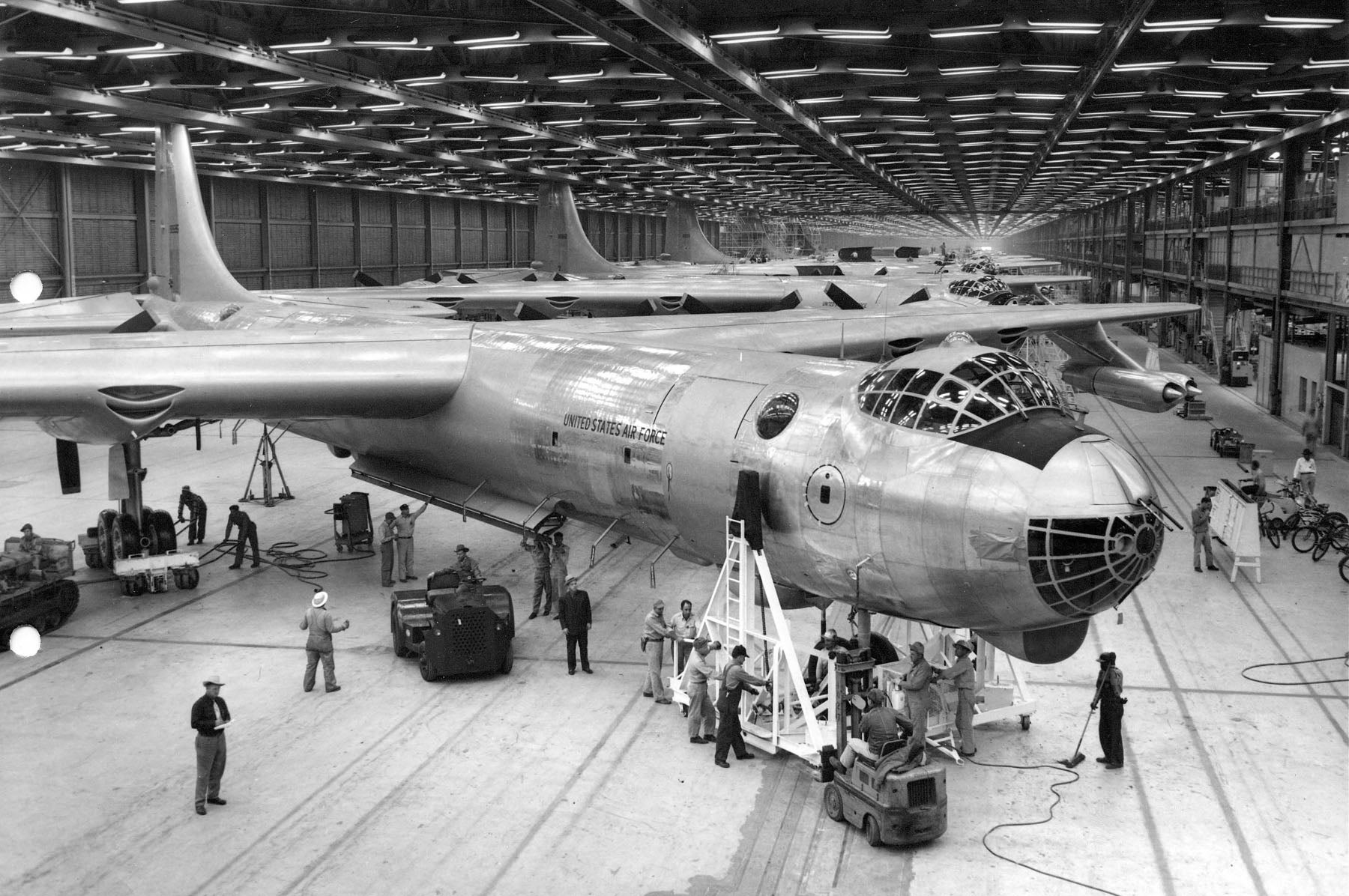
RB-36D aircraft under construction in the Convair plant
The RB-36D was outwardly identical to the B-36D, but had a larger crew of 22, the additional crew members being needed to operate and maintain the photo-recon equipment. The forward bomb bay was replaced by a pressurized, manned compartment that was filled with 14-23 cameras, comprised of various combinations of K-17C, K-22A, K-38, and K-40 cameras. This compartment included a small darkroom where photo technicians would develop the film. The second bomb bay contained up to 80 T-86 !!!error: Indecipherable SUB-paragraph formatting!!! , while the third bay could carry an extra droppable fuel tank of three thousand gallons. The fourth bomb bay carried !!!error: Indecipherable SUB-paragraph formatting!!! equipment. The extra fuel tanks increased the flight endurance to up to 50 hours, and the RB-36D had an initial ceiling of 50,000 feet. One RB-36, s/n 44-92088, was further modified to carry a !!!error: Indecipherable SUB-paragraph formatting!!! , nicknamed “Pie Face”, or the “Boston Camera”, which featured a 6,096mm (240in) focal length. The K-42 produced an 18 x 36 inch negative, and could resolve a golf ball from 45,000 feet up.
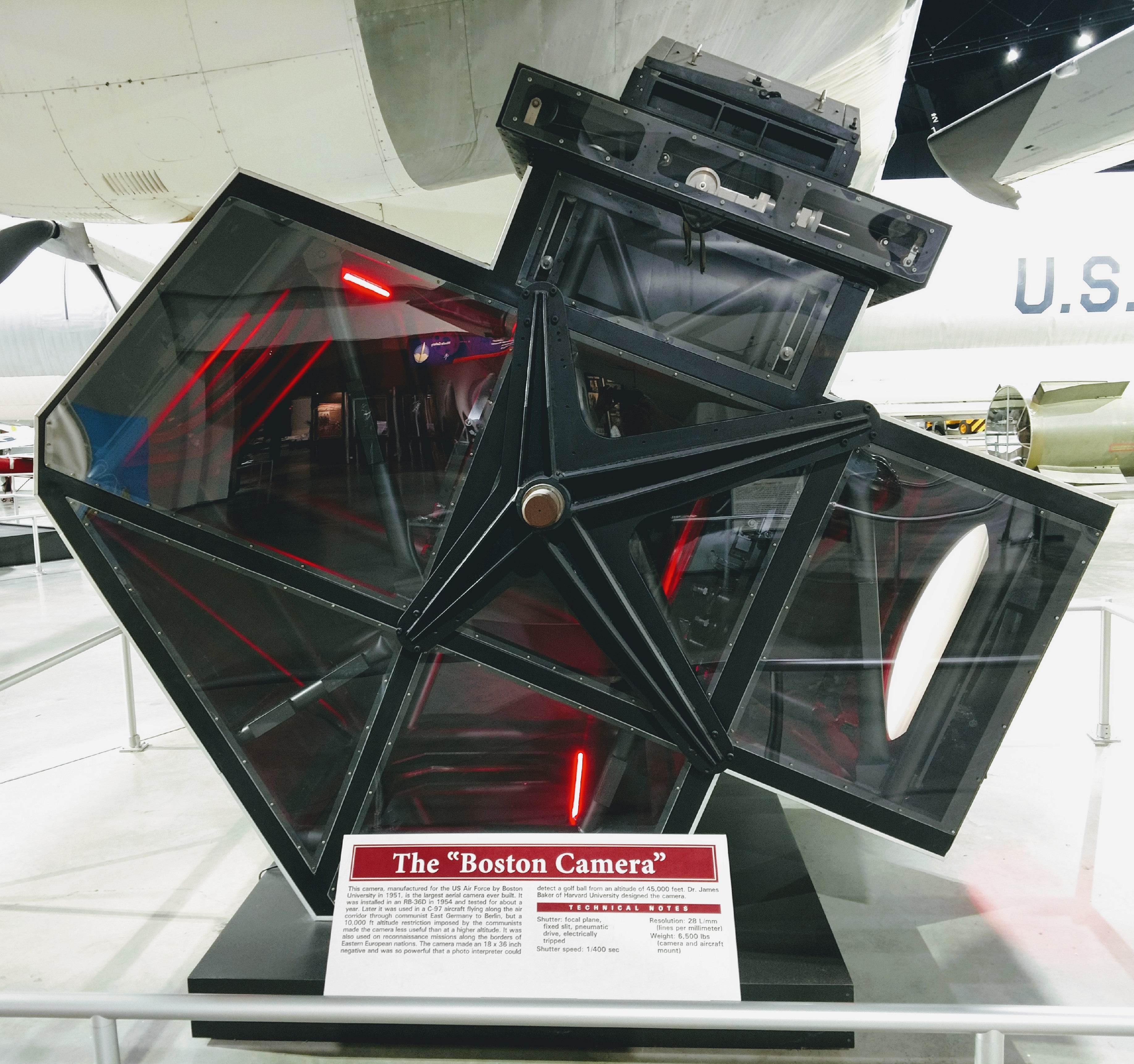
Pie Face, on display at the USAF Museum in Dayton
At the time of their construction, the B-36 was the only aircraft that could carry the giant Mk. XVII or Mk. XXIV Hydrogen bombs, though they could also carry conventional bombs as well, and were specially designed to accommodate the !!!error: Indecipherable SUB-paragraph formatting!!! “earthquake” bombs, with each B-36 able to carry two of the 43,600lb bombs.
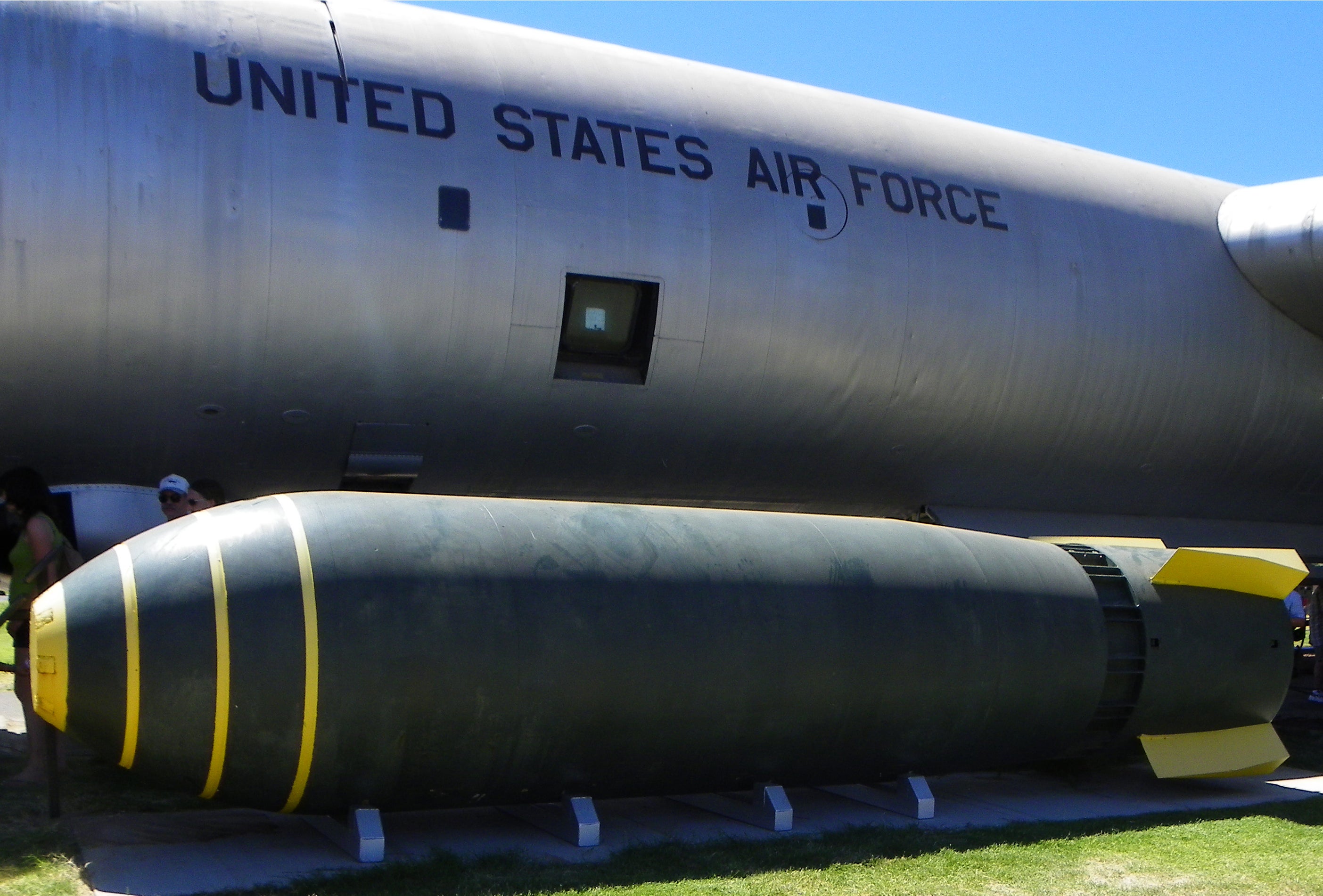 !!!CAPTION ERROR: MAY BE MULTI-LINE OR CONTAIN LINK!!!
!!!CAPTION ERROR: MAY BE MULTI-LINE OR CONTAIN LINK!!!
With the rapid development and proliferation of high-speed, high-altitude jet fighters like the MiG-15, as well as Soviet advancements in surface-to-air missiles, making overflight of targets by propeller-driven aircraft suicidal at best, along with the US’ own work on ICBMs, the B-36s days at the point of the nuclear spear were limited, and they were withdrawn from service beginning in 1956. Delays with procurement of the B-52 slowed the B-36's draw-down, but by 1959 the last B-36Js had been retired. Only !!!error: Indecipherable SUB-paragraph formatting!!! survive as museum pieces, with the remainder having been recycled at AMARC by 1961.

B-36s await their undoing under the Tuscon sun.